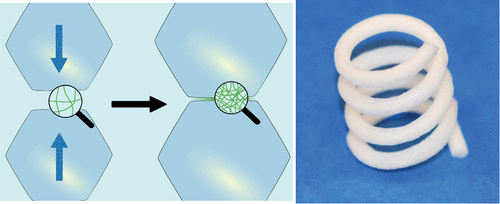当前位置:
X-MOL 学术
›
Biomacromolecules
›
论文详情
Our official English website, www.x-mol.net, welcomes your
feedback! (Note: you will need to create a separate account there.)
Cross-Linked and Shapeable Porous 3D Substrates from Freeze-Linked Cellulose Nanofibrils.
Biomacromolecules ( IF 5.5 ) Pub Date : 2018-11-21 , DOI: 10.1021/acs.biomac.8b01412 Johan Erlandsson 1 , Hugo Françon 1 , Andrew Marais 1 , Hjalmar Granberg 2 , Lars Wågberg 1, 3
Biomacromolecules ( IF 5.5 ) Pub Date : 2018-11-21 , DOI: 10.1021/acs.biomac.8b01412 Johan Erlandsson 1 , Hugo Françon 1 , Andrew Marais 1 , Hjalmar Granberg 2 , Lars Wågberg 1, 3
Affiliation

|
Chemically cross-linked highly porous nanocellulose aerogels with complex shapes have been prepared using a freeze-linking procedure that avoids common post activation of cross-linking reactions and freeze-drying. The aerogel shapes ranged from simple geometrical three-dimensional bodies to swirls and solenoids. This was achieved by molding or extruding a periodate oxidized cellulose nanofibril (CNF) dispersion prior to chemical cross-linking in a regular freezer or by reshaping an already prepared aerogel by plasticizing the structure in water followed by reshaping and locking the aerogel into its new shape. The new shapes were most likely retained by new cross-links formed between CNFs brought into contact by the deformation during reshaping. This self-healing ability to form new bonds after plasticization and redrying also contributed to the mechanical resilience of the aerogels, allowing them to be cyclically deformed in the dry state, reswollen with water, and redried with good retention of mechanical integrity. Furthermore, by exploiting the shapeability and available inner structure of the aerogels, a solenoid-shaped aerogel with all surfaces coated with a thin film of conducting polypyrrole was able to produce a magnetic field inside the solenoid, demonstrating electromagnetic properties. Furthermore, by biomimicking the porous interior and stiff exterior of the beak of a toucan bird, a functionalized aerogel was created by applying a 300 μm thick stiff wax coating on its molded external surfaces. This composite material displayed a 10-times higher elastic modulus compared to that of the plain aerogel without drastically increasing the density. These examples show that it is possible to combine advanced shaping with functionalization of both the inner structure and the surface of the aerogels, radically extending the possible use of CNF aerogels.
中文翻译:

冷冻连接的纤维素纳米原纤维的交联和可变形多孔3D基质。
具有复杂形状的化学交联的高度多孔的纳米纤维素气凝胶已经使用冷冻连接程序来制备,该程序避免了交联反应和冷冻干燥的常见后活化。气凝胶的形状从简单的几何三维物体到漩涡和螺线管不等。通过在常规冰箱中进行化学交联之前,将高碘酸盐氧化纤维素纳米原纤维(CNF)分散体模制或挤出,或通过在水中塑化结构来重塑已制备的气凝胶,然后将气凝胶重塑并锁定为新形状,即可实现此目的。新形状最有可能被重塑过程中因变形而接触的CNF之间形成的新交联所保留。增塑和再干燥后形成新键的这种自我修复能力还有助于气凝胶的机械弹性,使其在干燥状态下循环变形,用水再溶胀,并在保持机械完整性的前提下重新干燥。此外,通过利用气凝胶的可成形性和可用的内部结构,螺线管形的气凝胶的所有表面均涂覆有导电的聚吡咯薄膜,从而能够在螺线管内部产生磁场,从而证明了电磁性能。此外,通过生物模仿巨嘴鸟鸟喙的多孔内部和坚硬外部,通过在模制外表面上涂上300μm厚的坚硬蜡涂层,可以形成功能化的气凝胶。与普通气凝胶相比,该复合材料的弹性模量高出10倍,而密度却没有大幅度提高。这些示例表明,可以将高级成型与气凝胶内部结构和表面的功能化结合起来,从根本上扩展CNF气凝胶的可能用途。
更新日期:2018-11-05
中文翻译:

冷冻连接的纤维素纳米原纤维的交联和可变形多孔3D基质。
具有复杂形状的化学交联的高度多孔的纳米纤维素气凝胶已经使用冷冻连接程序来制备,该程序避免了交联反应和冷冻干燥的常见后活化。气凝胶的形状从简单的几何三维物体到漩涡和螺线管不等。通过在常规冰箱中进行化学交联之前,将高碘酸盐氧化纤维素纳米原纤维(CNF)分散体模制或挤出,或通过在水中塑化结构来重塑已制备的气凝胶,然后将气凝胶重塑并锁定为新形状,即可实现此目的。新形状最有可能被重塑过程中因变形而接触的CNF之间形成的新交联所保留。增塑和再干燥后形成新键的这种自我修复能力还有助于气凝胶的机械弹性,使其在干燥状态下循环变形,用水再溶胀,并在保持机械完整性的前提下重新干燥。此外,通过利用气凝胶的可成形性和可用的内部结构,螺线管形的气凝胶的所有表面均涂覆有导电的聚吡咯薄膜,从而能够在螺线管内部产生磁场,从而证明了电磁性能。此外,通过生物模仿巨嘴鸟鸟喙的多孔内部和坚硬外部,通过在模制外表面上涂上300μm厚的坚硬蜡涂层,可以形成功能化的气凝胶。与普通气凝胶相比,该复合材料的弹性模量高出10倍,而密度却没有大幅度提高。这些示例表明,可以将高级成型与气凝胶内部结构和表面的功能化结合起来,从根本上扩展CNF气凝胶的可能用途。











































 京公网安备 11010802027423号
京公网安备 11010802027423号